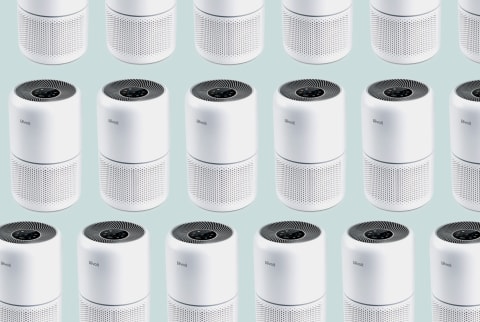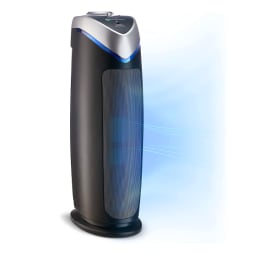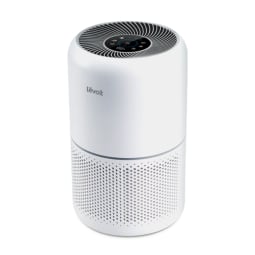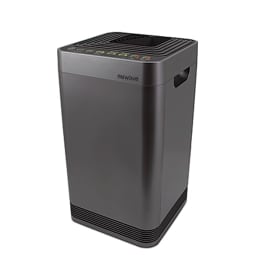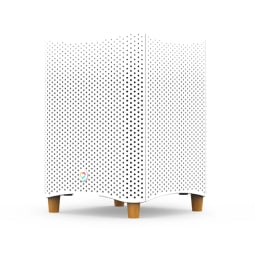Read on to learn what experts say about mold in our homes, guidance for dealing with it, and our picks for the best air purifiers for mold. While most air purifiers won’t eliminate the mold or mildew already growing on your surfaces, these machines help prevent mold spores from landing in the first place. “Top-rated air purifiers have the ability to remove small particles like spores, improving indoor air quality and reducing the chances for indoor mold growth, explains Michael Rubino, mold and air quality expert and author of The Mold Medic, an Expert’s Guide on Mold Removal. Allergist Anjuli Mehrotra, M.D., agrees. “Mold spores are usually under 40 microns in size, so air purifiers with HEPA filters can usually filter out airborne mold spores,” she adds. Microns are a unit of measurement equal to one-millionth of a meter—to give you an idea of how small 40 microns is, one grain of beach sand is typically between 100 and 10,000 microns. “Mold is actually present around us everywhere, both indoors and outdoors,” continues Mehrotra. “It does not always cause health issues, but people with allergies and asthma may be more sensitive to molds causing symptoms like coughing, wheezing, or nasal symptoms like sneezing or congestion. Exposure to excessive amounts of mold via airborne mold particles may trigger irritation of the eyes, nose, skin, throat, and lungs. People with suppression of their immune system or chronic lung or respiratory disorders may be at increased risk of infection from mold.” “For those who are attempting to determine if an inspection is necessary, at-home options such as The Dust Test can begin to set the foundation for figuring out if there’s a contamination situation present,” Rubino adds. When it comes to choosing the best air purifier for mold, Rubino says the key is to find a machine with technology that eliminates the particles from the air, so they don’t just blow right back into the surrounding environment. “Air purifiers should at least meet HEPA status, meaning they remove 99.97% of particles as small as 0.3 micron. That being said, some species of mold can create microscopic toxins called mycotoxins, which are even smaller than mold spores. Finding air purifiers that can eliminate particles smaller than 0.3 micron can help cleanse the air further,” he explains. HEPA filters (or High-Efficiency Particulate Air filters) are the only type that’s certified to meet the U.S. Department of Energy’s standards4. HEPA filters are able to capture 99.97% of particles up to 0.3 micron. However, the Department of Energy notes that the diameter specification of 0.3 micron responds to the worst case—HEPA filters are still extremely efficient when it comes to trapping particles that are larger or smaller than 0.3 micron. Cost of filter replacements Most air purifiers also include at least one additional layer of filtration with the HEPA filter. Depending on the design, this could mean carbon (or activated charcoal) filters that filter smoke, gases, and odors; pre-filters for larger particles; or ionizers to grab the smallest particles in the air. While additional filters can be helpful, you’ll want to consider the cost of replacing them. Filter prices range from $30 to $100 for replacements, but the cadence in which you’ll need to swap them out varies by machine. Coverage, or CADR rating Most air purifier brands provide a Clean Air Delivery Rating (CADR) to indicate how effective a product is at turning over the air in a given square footage. It’s important to know the limits of each product so you can manage your expectations accordingly. Most brands give a numerical value or estimated square footage for the purifier’s reach. The Molekule purifier is more expensive than others, but it certainly gets the job done—and it looks great in your home. Bonus: it’s incredibly quiet, at just 33 decibels on the lowest setting and 64 on the highest. The brand offers a generous warranty, too, so you can feel confident in your purchase. On the downside, the filters need to be replaced fairly regularly: every 3 months for the pre-filter and every 6 months for the PECO-filter. Great for anyone who doesn’t want to deal with an app or display, this is one of the most straightforward picks on our list: there’s only one button to switch between three speeds, and an LED light that tells you when it’s time to change your filter. Some negative reviews mention a plastic-like smell when this purifier runs, especially when it’s new, but it does seem to go away with time. A few reviews suggest that this purifier might not have the longest lifespan. Additionally, some say while it started quiet, the machine got louder over time. The brand has an optional companion app to control this purifier and view your room’s status no matter where you are. The machine uses 5-stage filtration, has six fan speeds, several timer options, an auto mode, and a display that tells you the air quality status in the room. The company sells several compatible HEPA filters, including a filter called “The Overreactor,” which is designed to grab even the smallest of particles. “The best way to determine if you have mold growing in your home is to hire a qualified professional to come and inspect the building,” Rubino explains. “This individual should spend hours carefully analyzing the home’s interior and exterior and use various testing methodologies.” Other indicators of indoor mold growth include:
- Visible growth (make sure to check hotspots such as the basement, attic, appliances, crawl spaces, underneath sinks, and carpeting)
- Water damage
- An earthy, musty, stale, cigar-like odor
- Chronic health conditions with seemingly no root cause “They also add a layer of protection for the HVAC system: Filtering out small particles like mold spores reduces the chance that growth begins in the unit. As the lungs of the home, mold growth in the system can lead to contamination being spread throughout the entire indoor space.”



